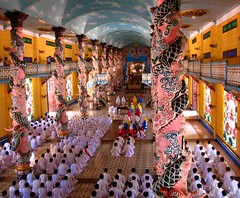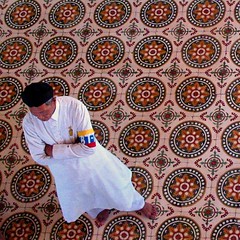After realizing that I had already spent a week in Ho Chi Minh City, I decided to make one last day-trip and then continue on northward to Dalat. On advice from some fellow travelers I booked a cheap half-day excursion to Tay Ninh and Cu Chi to visit the Cao Dai Holy See and the Cu Chi tunnels.
The first stop was the Cao Dai Great Temple (Cao Dai Holy See) in Tay Ninh province to witness the daily 12:00pm ceremony. The Cao Dai faith is something unique to Vietnam and like nothing I’ve ever heard of. Here are some quoted paragraphs from OffTheRails.com (which is in turn quoted from an issue of Giant Robot magazine):
The Divine Eye gazes unblinkingly from the enormous globe on the altar. Twenty-eight dragon-encrusted columns, representing the twenty-eight manifestations of the Buddha, run the entire length of the immense chamber. The temple’s enormous windows, all emblazoned with the Eye, let in the muted sunlight. Lao Tze, the Sakyamoni Buddha, and Confucius share the stage with Jesus Christ on the fronton above the altar. The Great Divine Temple, epicenter of the Cao Dai religion, is unlike any other house of worship in the world. Cao Daism was founded in southern Viet Nam in 1926 and claims six million adherents. Cao Dai temples dot the Mekong Delta, but the faith’s world headquarters is the Holy See compound which lies just outside the Vietnamese city of Tay Ninh, about two hours northwest of Saigon, near the Cambodian border. A full appreciation of the temple requires some knowledge of the Cao Dai religion. While many other religions are insular, Caodaism trumpets its foundations in other faiths. Caodaists describe their religion as the unification of Buddhism, Taoism and Confucianism: These faiths are represented in Cao Dai theology through such concepts as reincarnation, vegetarianism and yin and yang and also on the Cao Dai banner - a tri-colour with one colour for each religion. Cao Daism garners inspiration from farther afield as well: Striding a spire high on the temple’s roof is the Hindu trinity of Brahma, Shiva and Krishna. A mural inside the temple commemorates French novelist Victor Hugo, Chinese Nationalist Party leader Sun Yat Sen and Vietnamese poet Trang Trinh as three saints, witnesses to the 3rd alliance between God and humanity. And while Cao Dai theology is largely Eastern, the hierarchy is clearly Western: The organizational structure closely mirrors the Catholic Church, with bishops, archbishops, cardinals, and a Pope.
If you’re interested, googling “Cao Dai Religion” turns up several nice articles about Caodaism.
We arrived just before noon and had some time to walk around the outside of the temple and then get settled inside for the start of the ceremony. Although those who practice Cao Dai normally refuse to be photographed during worship, the upper balcony of the temple is open to tourists and their cameras - and the temple is now one of the major tourist attractions of the region. At 12:00 sharp, the congregation of white-robed worshippers filed into the main hall and seated themselves on the floor in an organized pattern, grouped according to sex and rank. The hall is “stepped” in nine levels, representing the nine main levels of rank within the church. At the moment, none of the priests are qualified to replace Cao Dai’s first and only pope who died in Cambodia (where his body still remains) so there are a set of empty seats nearest the altar on the ninth level. Upstairs, a choir of young singers and musicians play and chant the Cao Dai prayers in an eerie continuous flow while the people below sing along in lower tones. The acoustics of the temple create a hypnotizing and beautiful sound.
After the ceremony I got back on the bus and rode to Cu Chi. Cu Chi is the province made famous during the Vietnam war as a Viet Cong stronghold which helped Ho Chi Minh’s soldiers fight off the Americans who otherwise occupied most of the south. The secret to their success was an elaborate network of tunnels, some of which were left over from the earlier war against the French. At the height of the war, hundreds of soldiers were living underground in the middle of enemy territory in some 200km of tunnels. One of the US bases in the region was unknowingly built right on top of an old set of tunnels, which the VC used to gather intelligence and launch devastating surprise attacks. The more elaborate parts of the tunnel network were 3 levels deep and even had underground hospitals, kitchens, bunkers and meeting rooms.
Visiting the tunnels nowadays means a trip to one of the most blatant tourist-traps in Vietnam. The most enjoyable part of the otherwise horribly kitchy tour was the introductory propoganda film, produced in Hanoi by the VC during the war. My camera’s batteries had died while shooting a ton of photos at the Cao Dai temple, but there werent too many inspiring photo-ops anyway.
During the tour I was hanging out with a lovely couple from Australia (originally Poland). Since my chef friend had bailed out on our plans to meet up for a big meal the other day, I invited them to join me for dinner. I called up the chef guy to get the address and after the tour we walked out to the restaurant (Au Pagolac in District 1). Their specialty is a 7-course affair called “7-ways beef” so we ordered enough of that for everyone. It turned out to be an amazing meal, and even better than the food was sitting, drinking and talking with Eva and Ted for a while afterwards. They gave tons of great advice about visiting Poland which is one of my planned stops in Europe (when I finally get there…)

